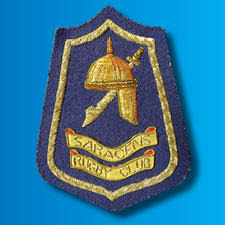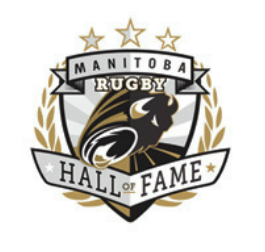
The foundation of this successful Saracens team was the four pillars or “founding fathers” of the Club, with a dedicated and colourful supporting cast. Enthusiastic imports and local Canadians combined to forge the Saracens early and consistent success. Imports included Peter Press, a coach whose eloquent demands and punishing practices developed stamina for the long run, and Ken Adams, whose combination of shifty speed and smart play bewildered opponents and taught the rookies. Home grown talents were Howie Goss, whose tenacity and heart anchored the pack, and Gerry Nufer, whose uncompromising competitive nature sparked the team.
Founded in 1968 and capturing senior men’s Premier provincial championships that year and in 69, plus 2nd Division championships in 69 & 70, by the early 1970’s the Saracens “train” was building steam for six Premier Provincial championships in its first eight years, four occurring consecutively from 1972 to 1975. In an era when few locally played the game, with no substitutions or injury replacements, commitment was high to not only field a team, but to win consistently. The Saracens club was adept at both attracting imports and developing local talent, converting football players to the sport. With strong 1st and 2nd Division teams, and at one point two 2nd Division teams, the Scimitars & the Sabres, the Saracens demonstrated great recruitment and talent, the depth of which was to show for many years to come.
Commitment described the Saracens and its 1972 to 1975 team. Commitment:
Club records from the time show commitment to events hosted by other clubs with Saracens urged to support them, and that support actively reciprocated by other clubs annually competing at SNAFU. As one of the top tournaments in North America, SNAFU regularly drew teams from Georgia, Chicago, Minneapolis, St. Paul, Kansas City, Regina, Saskatoon, Edmonton, BC, and farther afield from London and the Caribbean. Starting in 1971, and still going, SNAFU offered opportunities to compete and celebrate the game. Each local team hosted a visiting side that built league solidarity in a long weekend of competition and camaraderie, establishing longstanding inter-city connections that exist to this day.
Stamina was essential as both practices and games were contested at a high level. Inter-squad games were as tenacious as league games, followed by great camaraderie, a rugby tradition. In an era of no substitutions, one was expected to finish the game, and then drink a beer with your previous foe of a few moments ago, and now a very fine fellow. The league was smaller then, so chance meetings around town were cause for celebration with club members or opponents.
The team’s high level of play was recognized by the League, with Saracens regularly placing many players and coaches on provincial sides for Inter-Provincial competitions. Also of note were hard fought contests, with world class touring sides, Lliannelli in 1973 and Lansdowne in 1974. As the team to beat, the 1972 to 75 Saracens helped raise the level of competition to the point where other clubs captured Premier Provincial championships during the years of 1976 to 1978.
Farther afield, the Saracens and the 1972 to 75 team tested their stamina and metal by going on tour. Facing other teams, differing tactics and strategies helped build Saracen skills. The team toured actively, south, starting with frequent trips to Chicago, then Dubuque, Madison, Minneapolis. Annual tours west included Regina (Prairie Cities) and Saskatoon (Louis Riel Days), with open invitations to come to SNAFU in mid-summer.
Off the field, these same Saracens fostered high school rugby, as players took time to coach high school teams at Sisler, St. John’s, Sansome, Westwood, Garden City and Transcona Collegiate. Many in the Saracens’ successful “second wave” of 1979 to 1986 were players who started their rugby careers at Sisler and St. Johns High Schools.
The Saracens 1972 to 75 team built upon a solid foundation, with commitment to the game and each other. They lived up to it, on and off the field. It was a club and team that grew stronger year after year and served to elevate both the development and caliber of the game and the league in the province of Manitoba for future years to come. The Saracens 1972 to 75 team are proud partners of the growing history of rugby on the Prairies.
Founded in 1968 and capturing senior men’s Premier provincial championships that year and in 69, plus 2nd Division championships in 69 & 70, by the early 1970’s the Saracens “train” was building steam for six Premier Provincial championships in its first eight years, four occurring consecutively from 1972 to 1975. In an era when few locally played the game, with no substitutions or injury replacements, commitment was high to not only field a team, but to win consistently. The Saracens club was adept at both attracting imports and developing local talent, converting football players to the sport. With strong 1st and 2nd Division teams, and at one point two 2nd Division teams, the Scimitars & the Sabres, the Saracens demonstrated great recruitment and talent, the depth of which was to show for many years to come.
Commitment described the Saracens and its 1972 to 1975 team. Commitment:
- to the exhausting Churchill Drive practices with backs carrying forwards up the hill on their shoulders, and Peter’s favourite finale, the “run to the pumphouse…and back!”;
- to each other, on and off the field, as a band of brothers;
- to the club, playing, touring and winning;
- to the game, a revelation to many, and;
- to the league, as evidenced in supporting events of other clubs, high school rugby, hosting touring sides and initiating SNAFU, a tournament tradition that continues to this day.
Club records from the time show commitment to events hosted by other clubs with Saracens urged to support them, and that support actively reciprocated by other clubs annually competing at SNAFU. As one of the top tournaments in North America, SNAFU regularly drew teams from Georgia, Chicago, Minneapolis, St. Paul, Kansas City, Regina, Saskatoon, Edmonton, BC, and farther afield from London and the Caribbean. Starting in 1971, and still going, SNAFU offered opportunities to compete and celebrate the game. Each local team hosted a visiting side that built league solidarity in a long weekend of competition and camaraderie, establishing longstanding inter-city connections that exist to this day.
Stamina was essential as both practices and games were contested at a high level. Inter-squad games were as tenacious as league games, followed by great camaraderie, a rugby tradition. In an era of no substitutions, one was expected to finish the game, and then drink a beer with your previous foe of a few moments ago, and now a very fine fellow. The league was smaller then, so chance meetings around town were cause for celebration with club members or opponents.
The team’s high level of play was recognized by the League, with Saracens regularly placing many players and coaches on provincial sides for Inter-Provincial competitions. Also of note were hard fought contests, with world class touring sides, Lliannelli in 1973 and Lansdowne in 1974. As the team to beat, the 1972 to 75 Saracens helped raise the level of competition to the point where other clubs captured Premier Provincial championships during the years of 1976 to 1978.
Farther afield, the Saracens and the 1972 to 75 team tested their stamina and metal by going on tour. Facing other teams, differing tactics and strategies helped build Saracen skills. The team toured actively, south, starting with frequent trips to Chicago, then Dubuque, Madison, Minneapolis. Annual tours west included Regina (Prairie Cities) and Saskatoon (Louis Riel Days), with open invitations to come to SNAFU in mid-summer.
Off the field, these same Saracens fostered high school rugby, as players took time to coach high school teams at Sisler, St. John’s, Sansome, Westwood, Garden City and Transcona Collegiate. Many in the Saracens’ successful “second wave” of 1979 to 1986 were players who started their rugby careers at Sisler and St. Johns High Schools.
The Saracens 1972 to 75 team built upon a solid foundation, with commitment to the game and each other. They lived up to it, on and off the field. It was a club and team that grew stronger year after year and served to elevate both the development and caliber of the game and the league in the province of Manitoba for future years to come. The Saracens 1972 to 75 team are proud partners of the growing history of rugby on the Prairies.


